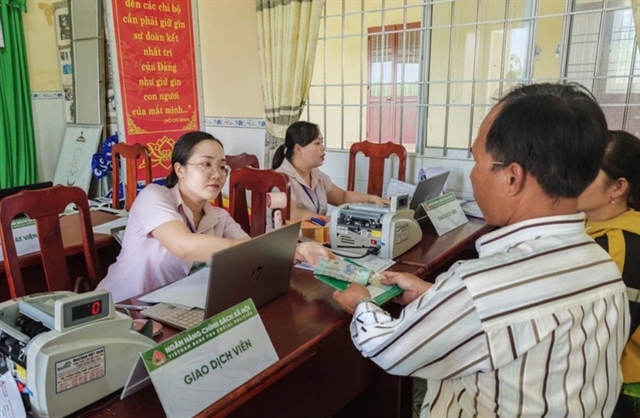 Business Beat
Business Beat

Last year the VPBank-owned FE Credit-Consumer Finance Services added 2.7 million accounts to take its total number of customers to 3.3 million.
 |
| Last year the VPBank-owned FE Credit-Consumer Finance Services added 2.7 million accounts to take its total number of customers to 3.3 million. — Photo VPBank |
By Thiên Lý
Last year the VPBank-owned FE Credit-Consumer Finance Services added 2.7 million accounts to take its total number of customers to 3.3 million.
This helped the company expand its market share to nearly 70 per cent and achieve pre-tax profits of VNĐ2 trillion (US$88.89 million) for the year.
FE Credit plans to roll out many innovative products and improve its existing products and services this year.
The company has also signed a $100 million contract with Switzerland-based Credit Suisse to strengthen its finances.
Many of its rivals, too, are actively preparing for the competition which is forecast to become fierce in the consumer finance market.
Among them is Home Credit, which has 4.9 million customers and reported turnover growth of 94 per cent last year.
The company said it would continue to expand by using modern technologies to launch new services like lending online.
Some 78 per cent of potential borrowers said they would prefer to sign an online loan agreement with the company.
To facilitate this, Home Credit has unveiled a new service that allows customers to borrow from any bank after signing the loan agreement.
Why do credit companies have such high expectations of the Vietnamese finance market?
Analysts said the market’s potential is massive since the number of working-age people is increasing rapidly together with a rise in the middle class.
These are pushing up demand for goods and services, and, thus, consumer finance.
The Business Monitor International (BMI ) and the World Bank attribute the strong growth of the consumer finance market to Việt Nam’s rapid urbanisation.
The country is estimated to have some 18 million adults living in urban areas, which is expected to further increase considering the speed of urbanisation.
Most of them are considered to be potential customers for financial services.
To enter the race, many foreign finance companies are ready to buy into local players.
Japan’s Credit Saison and Shinsei Bank now respectively own 49 per cent of HD Saison and Military Bank’s MC Credit.
Not wanting to miss out, many lenders including SHB have established their own finance companies.
SHB, for instance, acquired the Vinaconex-Viettel Finance Joint Stock Company and bolstered its finances greatly by increasing chartered capital to nearly VNĐ12 trillion before establishing a consumer finance company (SHB Finance) with a legal capital of VNĐ1 trillion.
The managements of many banks have warned that the industry is likely to face many hurdles to lending like high loan interest rates, exchange rate volatility, and, especially, bad debts.
Their apprehensions are based on the fact that the Reserve Federal, the US central bank, has announced plans to hike interest rates on the dollar three times this year.
This would put pressure on exchange rates, thus affecting the interest rates on the đồng.
But with cost cutting likely to prove very difficult, the lenders will find it hard to reduce loan interest rates.
Risk provisioning for bad debts requires them to set aside large amounts of money.
In the event, most banks are cautious while outlining their business plans for the year.
An OCB executive said last year pre-tax profits exceeded the target by 10 per cent. But this year the profit target is only 10-15 per cent higher than last year’s though dividends will remain unchanged.
In the pre-bad debts era many banks could routinely expect profit growth to be much higher than 10-15 per cent a year.
ACB also expects to achieve a growth rate of 10-15 per cent this year.
Last year BIDV achieved an estimated VNĐ7.5 trillion in pre-tax profits, a year-on-year increase of 7 per cent.
But it is not confident about achieving strong profit growth this year since bad debts cannot be resolved immediately.
In the first three quarters of 2016 BIDV earmarked nearly VNĐ7 trillion for risk provisioning, up 80 per cent from the same period the previous year.
Clearly, bad debts remain a big headache for all the banks, including the behemoths.
The big concern here is that the Việt Nam Asset Management Company (VAMC) bought around VNĐ230 trillion worth of bad debts in the last three years, but most remain unsettled mainly due to legal difficulties.
The procedures for disposing of assets against loans are highly complicated.
Though credit activities have improved significantly and are expected to be better this year, banks will remain wary of lending because they have to carefully control the quality of credit to limit bad debts.
Sài Gòn Thương Tín Commercial Joint Stock Bank (Sacombank) is still very attractive to foreign investors, according to one of its top executives.
In fact, a foreign investor is keen on buying a 20 per cent stake at VNĐ15,000 per share, a 100 per cent premium on the market price, he said.
The lender said many foreign investors have sought to buy stakes.
It has entered into negotiations with some of them to identify those on the same page as itself in terms of business strategies and goals for future development.
The Hồ Chí Minh Development Joint Stock Commercial Bank (HDBank) and VPBank are also being courted by foreign investors.
Their managements are in fact in the process of negotiating with some of the suitors, and are expected to wrap them up before or immediately after their proposed listing.
Many banks like SCB, Bắc Á bank and Việt Á Bank are also in the process of restructuring.
According to the law, foreign ownership is capped at 30 per cent.
A foreign individual is allowed to hold no more than 5 per cent and a foreign organisation, 15 per cent.
Based on these criteria, few banks can sell any mores stakes to foreign investors, with only some not having yet sold the maximum permitted stakes.
This means that while foreign investors as well as Vietnamese banks may be keen, is no way to do it.
Meanwhile, the low cap means foreign investors have little say in the decision making process and lenders find it hard to achieve their ambitions.
So both sides expect the Government to increase the cap to above 30 per cent.
Analysts say such an increase is unavoidable since it would help banks improve their restricted finances and governance, and cope better with the growing competition. — VNS



